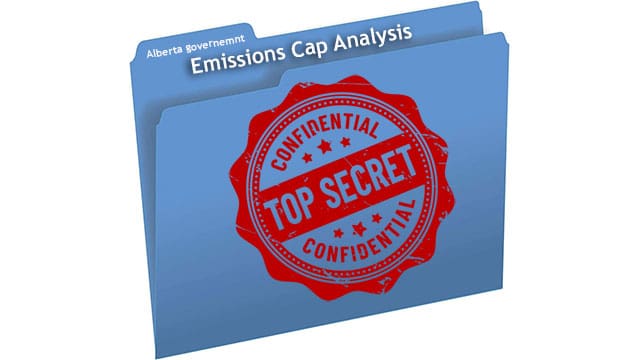All emissions cap analyses must be released to ensure sound policy decisions
 Two recent reports commissioned by the Alberta government – the Deloitte report and the Conference Board of Canada report – predict significant economic damage from the proposed federal Oil and Gas Emissions Cap (OGEC), including potential cuts in oil and gas production. However, I believe that this might not be the full story.
Two recent reports commissioned by the Alberta government – the Deloitte report and the Conference Board of Canada report – predict significant economic damage from the proposed federal Oil and Gas Emissions Cap (OGEC), including potential cuts in oil and gas production. However, I believe that this might not be the full story.
In January 2024, before the public release of the Conference Board of Canada report, a document prepared by Alberta Environment and Protected Areas (EPA), titled Summary: Impact of Oil and Gas Sector GHG Emissions Cap Analysis by Conference Board of Canada, highlighted several caveats to the analysis. The Conference Board of Canada’s analysis may overestimate the negative impacts of implementing the federal OGEC by:
- Assuming that emissions reductions can only be achieved by cutting oil and gas production rather than considering other abatement options like technology adoption.
- Assuming emissions efficiency will decrease in the future based on past trends, without accounting for potential improvements in efficiency.
- Overestimating the negative impact on employment, as it does not assess labour mobility to other sectors.
 |
| Related Stories |
| Oil giants plead poverty over emissions cap despite soaring profits
|
| Trudeau’s emissions cap a threat to Canadian prosperity
|
| Public awareness essential for achieving net-zero emissions
|
These caveats suggest that the predicted economic damage might not be as severe as the reports indicate. The EPA had been conducting its own internal modelling of the OGEC’s impact on the Alberta economy. On January 23, 2024, the Air and Climate Change Policy Division of the EPA prepared a 17-page PowerPoint presentation titled EPA Impact Analysis of Federal Oil and Gas Emissions Cap, which detailed their modelling results.
Despite numerous requests over the past couple of months, the EPA has not released its own modelling of the OGEC’s impact. If EPA’s internal modelling aligned with the Conference Board of Canada and Deloitte analyses, the Alberta government would have publicly released it as supporting evidence. So, what gives?
As I noted in a previous Troy Media column, the Alberta government has a responsibility to taxpayers to release all impact analyses of federal and provincial climate change policies as part of a robust Alberta Climate Change Accountability Framework. Transparency is crucial in ensuring that the public understands the full implications of such policies and can make informed decisions.
If the results from EPA’s internal analyses differ from the Conference Board of Canada and Deloitte conclusions, possibly due to the caveats expressed in January 2024, Albertans deserve to know this information. The discrepancies between the different analyses could provide a more nuanced understanding of the OGEC’s impact and help devise more effective emissions reduction strategies without causing undue harm to the economy.
Moreover, the Alberta government’s reluctance to release EPA’s internal modelling raises questions about the validity and completeness of the publicly available reports. The government must provide a comprehensive and transparent account of all analyses to ensure that policy decisions are based on the most accurate and complete information available.
The potential economic impacts of the OGEC are a matter of significant public interest, and Albertans have a right to access all relevant information. This transparency will not only foster trust between the government and its citizens but also enable a more informed and balanced discussion on how best to address climate change while protecting the province’s economic interests.
While the Deloitte and Conference Board of Canada reports predict significant economic damage from the OGEC, the full story may be more complex. The caveats noted in the EPA’s internal analysis suggest that there may be other viable options for reducing emissions without severely impacting the oil and gas industry.
The Alberta government must release all relevant impact analyses to provide a complete picture and ensure that policy decisions are based on the most accurate and comprehensive information available.
Lennie Kaplan spent over two decades in the public service of Alberta, including as a senior manager in the Fiscal and Economic Policy Division of the Ministry of Treasury Board and Finance, where he worked on cross-ministry initiatives evaluating the fiscal and economic impacts of federal and provincial climate change policies.
For interview requests, click here.
The opinions expressed by our columnists and contributors are theirs alone and do not inherently or expressly reflect the views of our publication.
© Troy Media
Troy Media is an editorial content provider to media outlets and its own hosted community news outlets across Canada.
